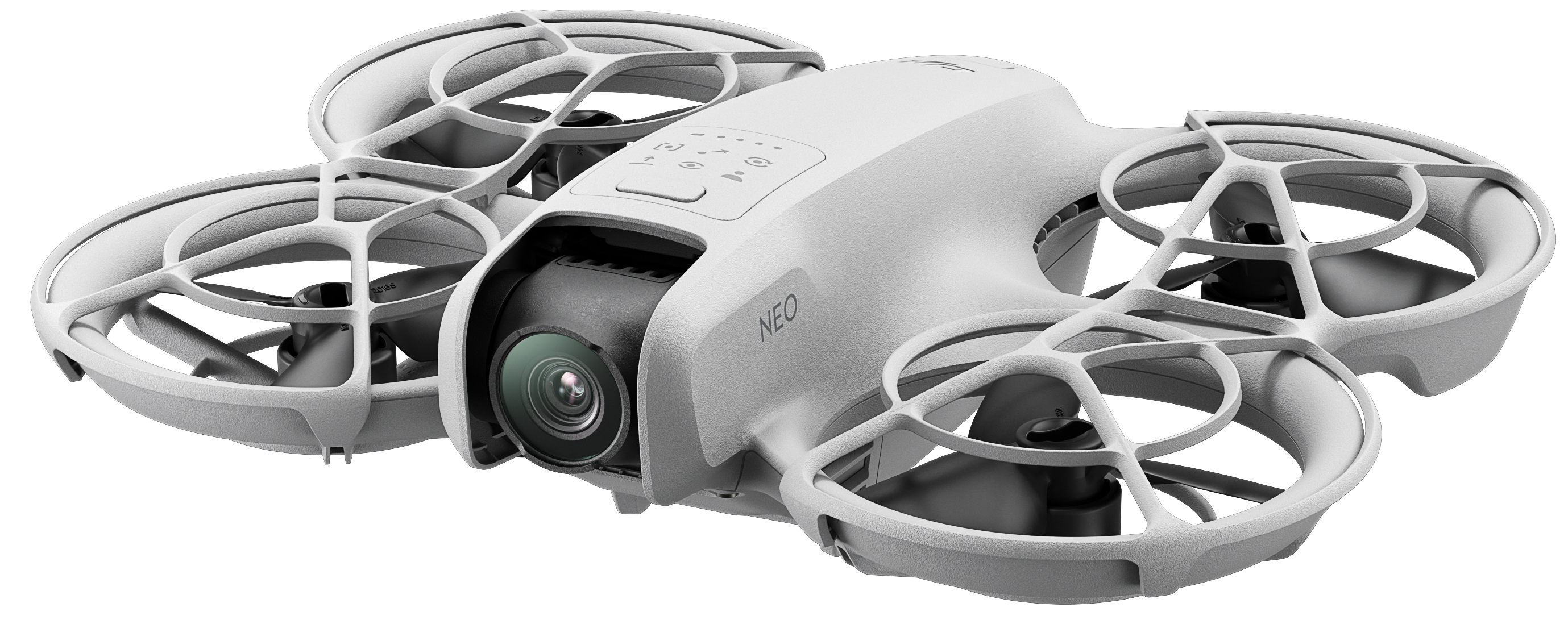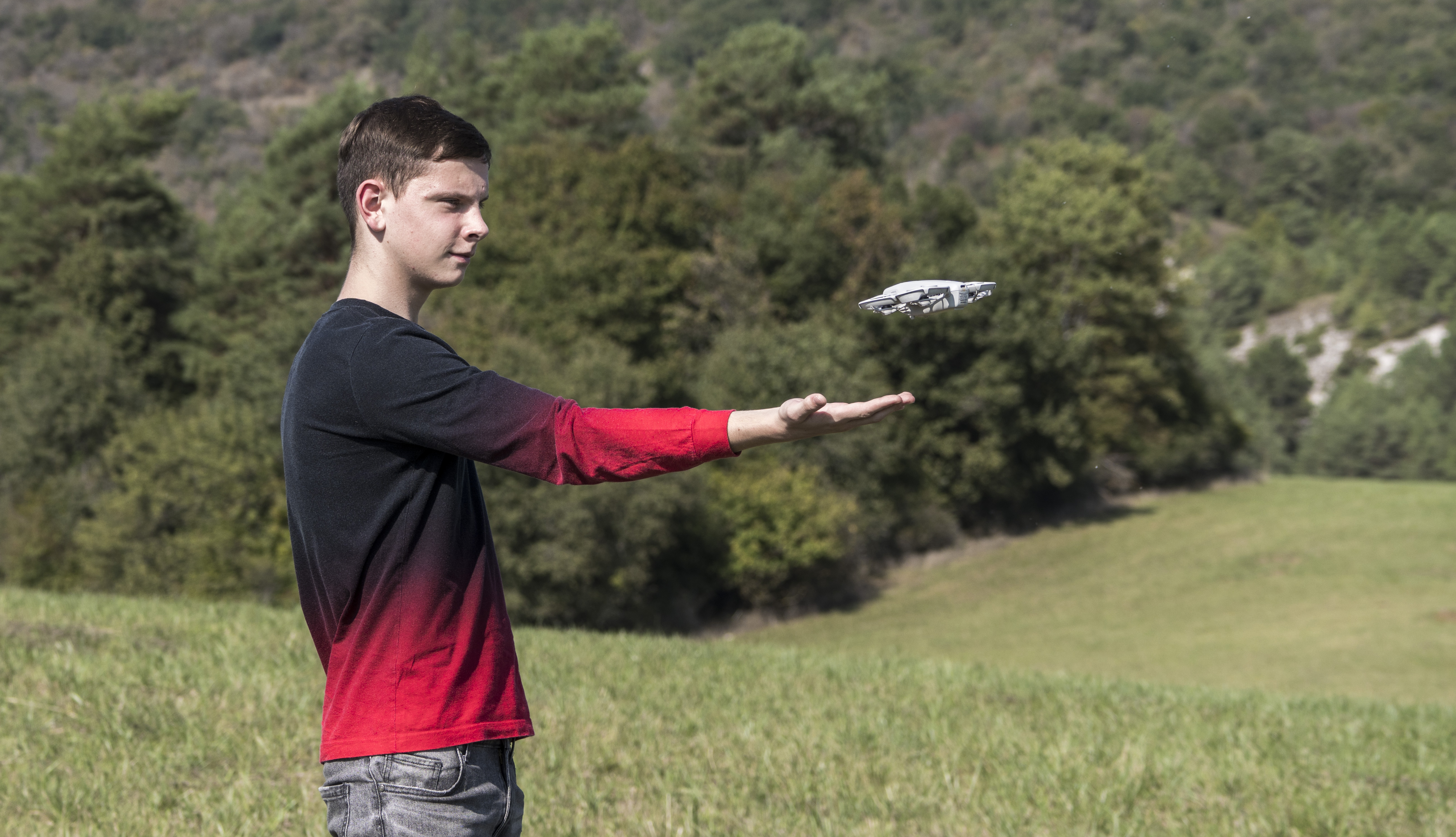DJI Neo is the latest and smallest addition to DJI’s drone family, and it comes with a lot of surprises. It offers the broadest possibilities of use, respectively control. In addition to autonomous flight, you can control it with your voice, mobile phone, classic two-stick controller DJI RC-N3, but also with DJI Motion Controller 3 together with Goggles 3. Thanks to this, the drone is aimed at a fairly wide range of users – from beginners to various travelers and athletes , lovers of FPV flying or drone fans who already have a drone from DJI. Even though the flight speeds are quite low in basic control, the drone is very nimble when maneuvering. The possibilities for taking pictures and filming are somewhat more limited, but they are very user-friendly. The main advantages of a drone are the ease of use and the fun it brings.
DJI Neo is a small and very light drone. Weighing only 135 grams, it is slightly larger than the palm of your hand, making it ideal for carrying and easy hand-held flight. Since it weighs less than 250 grams, it meets the regulations for drones in many countries, where this limit is crucial for registration. Since the drone has no impact protection sensors other than the camera and bottom height sensors, it is completely built to survive most common accidents. The propellers are protected from above and below, which ensures safety, whether the drone flies autonomously or is controlled manually. The camera is located in front, embedded in the outline of the hull and stabilized in one axis. Image stabilization is software-based with Rocksteady and HorizonBalancing modes that keep video steady when moving sideways up to 45 degrees. DJI Neo is equipped with a 12 Mpx 1/2-inch sensor that allows you to capture videos in 4K resolution at 30 frames per second. Photos can only be captured in JPEG format, which may be a limitation for more advanced users who prefer RAW formats for more flexibility in post-production. Video in 4K 30p uses an MPEG-4 container with H.265/HEVC compression with a data stream of max. 75 Mb/s. This is not much, but the image is subjectively well rendered, without artifacts, and for the purpose its quality is more than sufficient. The device does not have an SD card slot, it only uses internal storage with a capacity of 22 GB. This is enough for about 40 minutes of 4K 30p video. You can download videos from the drone via USB-C or via built-in Wi-Fi 6. The download is in full quality and, thanks to Wi-Fi 6, also very fast.

The basic use of the drone is its fully autonomous mode, or with the possibility of connecting to a mobile phone and configuring autonomous modes, or control. Therefore, it is not surprising that the drone is also sold separately, without any controller. After connecting via Wi-Fi to your smartphone, you can control it using the DJI Fly app. In addition to complete configuration, it also allows manual control. However, it should be remembered that this is limited by the Wi-Fi range, which is approximately 50 m. You can also turn on voice control in the application. Then just say “Hey, Fly!” and say the mode to start. After the countdown, the drone will automatically start in the selected mode. This type of use will be most appreciated by tourists, travelers, cyclists and the like, simply by users who pack it in their backpack and want to film themselves, for example, on a ridge, on a hill, on the beach, during a trek, etc. Just pull out the drone, select the Follow mode and it will follow you and film the environment in which you are moving. If you want to use the drone for longer distances, you will need the RC-N3 controller, in which you insert your smartphone and fly like a classic drone. In that case, it is better to buy the Fly More Combo straight away, in which, in addition to the drone and controller, you also get three batteries with a special charger for them. With the controller, you increase the range to several kilometers and use NEO like other camera drones. If you are interested in FPV flying, just purchase the DJI FPV Remote Controller 3 and DJI Goggles 3 and you can fly. However, it must be admitted that this equipment is already more expensive and you will pay almost 750 euros for it. After calculating, it basically comes without 50 euros for the price of Avata 2. But the point is that Avata 2 cannot fly autonomously and is almost twice as big. However, if you appreciate the small dimensions and versatile control options of NEO and want to occasionally fly with FPV, it can be an interesting choice. In combination with DJI Googles 3 and Motion Controller 3, you can even fly the same acrobatic elements as Avata 2 with NEO. In addition, if NEO is not enough time, just buy AVATA 2 separately and you are quickly upgraded.

However, you do not need a controller for basic flying. The manufacturer assumes that the most interesting object you would like to film is you, and the autonomous flight modes based on your tracking are adapted to this. Spotlight, Direction Track, Dronie, Circle, Rocket and Follow are available. Operation is very simple. There are two buttons on the top, the back button is a classic switch, so just press and hold a second time to turn it on or off. There’s a second button on the front next to an array of icons that indicate the various modes, and there’s also an LED battery indicator. With the button, you gradually switch modes, which the drone also announces to you by voice. After choosing the desired one, you place the drone on your palm with the camera facing you and hold the front button. A countdown begins, the drone takes off, the camera detects you and performs the required maneuver while following you.
- Circle – will circle around you with you in the center, you can enter the distance.
- Dronie – rises and gradually backs away from you, you can enter the distance.
- Rocket – rises directly above you.
- Spotlight – the drone hangs in place and follows you, turning behind you.
- Follow – flies behind you and follows you. It is the only mode where he can partially avoid obstacles in front of him through the camera.
- Direction Track – follows you from the direction you send it.
The drone preferentially lands in the palm. In the first three modes, it will always come back to you when it’s done, just put your palm on it and it will automatically land. At Spotlight, it stands still, so you walk up to it. In the other modes, he always follows you from further away than you would reach, and if you walk towards him, he will keep his distance. Then you just need to stop for a moment and the drone will approach you to land.
DJI Neo is relatively slow in normal modes compared to other models:
- Normal: 21,6 km/h
- Sport: 28,8 km/h
However, if you use the FPV controller in manual mode, the speed can reach up to 57.6 km/h, which offers a much more dynamic flight experience. However, this option is intended for more advanced users who have experience in FPV flight.
Image stabilization works very well thanks to the Rocksteady and HorizonBalancing modes, which is great for capturing video in flight. In stronger winds, a slight shake of the image can be seen, which is common for such small drones. Photos and videos have true colors, while the camera provides a sufficiently wide viewing angle of 117.6°. The maximum bitrate for 4K video is 75 Mbps, which is enough to make the footage look good, even if it is not intended for professional production. The drone doesn’t have support for ND filters, which means you’ll be limited to automatic exposure settings. DJI Neo is an interesting drone for beginners who are looking for a simple but powerful model, offering many flight options. Its small size and light weight make it ideal for those who want to carry the drone. Although the image and video quality is lower than that of specialized filming drones, it is still more than good and suitable for the purpose. A big advantage is that, in the case of a low budget, you can add accessories according to your needs and possibilities, while the drone can be used without everything. In addition, if you already have a DJI drone, you can use its controller.
PROS, CONS:
+ Dimensions and weight, autonomous functions, control options, ease of use
– Video only 4K 30p, does not support RAW photos
PARAMETERS:
DJI Neo Key Specifications: Camera: 12 Mpx 1/2-inch sensor; video: up to 4K at 30 frames per second; flight modes: Sport, Normal, Cine; battery: 1435 mAh, flight time up to 18 minutes; weight: 135 g; dimensions: 130 × 157 × 48.5 mm
- Cena: 199 EUR (drone only), Fly More Bundle with RC-N3 controller: 349 EUR
- Borrowed by: www.smartwear.sk
Source: www.nextech.sk


